Well Child Visit at 11 to 14 Years
Medically reviewed by Drugs.com. Last updated on Apr 6, 2025.
What is a well child visit?
A well child visit is when your child sees a healthcare provider to prevent health problems. Well child visits are used to track your child's growth and development. It is also a time for you to ask questions and to get information on how to keep your child safe. Write down your questions so you remember to ask them. Your child should have regular well child visits from birth to 18 years.
What development milestones may my child reach at 11 to 14 years?
Each child develops at his or her own pace. Your child might have already reached the following milestones, or he or she may reach them later:
- Breast development (girls), testicle and penis enlargement (boys), and armpit or pubic hair
- Menstruation (monthly periods) in girls
- Skin changes, such as oily skin and acne
- Not understanding that actions may have negative effects
- Focus on appearance and a need to be accepted by others his or her own age
What can I do to help my child get the right nutrition?
- Teach your child about a healthy meal plan by setting a good example. Your child still learns from your eating habits. Buy healthy foods for your family. Eat healthy meals together as a family as often as possible. Talk with your child about why it is important to choose healthy foods.
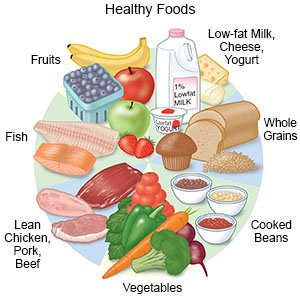
- Let your child decide how much to eat. Give your child small portions. Let him or her have another serving if he or she asks for one. Your child will be very hungry on some days and want to eat more. For example, your child may want to eat more on days when he or she is more active. Your child may also eat more if he or she is going through a growth spurt. There may be days when he or she eats less than usual.

- Encourage your child to eat regular meals and snacks, even if he or she is busy. Your child should eat 3 meals and 2 snacks each day to help meet his or her calorie needs. He or she should also eat a variety of healthy foods to get the nutrients he or she needs, and to maintain a healthy weight. You may need to help your child plan meals and snacks. Suggest healthy food choices that your child can make when he or she eats out. Your child could order a chicken sandwich instead of a large burger or choose a side salad instead of French fries. Praise your child's good food choices whenever you can.
- Provide a variety of fruits and vegetables. Half of your child's plate should contain fruits and vegetables. He or she should eat about 5 servings of fruits and vegetables each day. Buy fresh, canned, or dried fruit instead of fruit juice as often as possible. Offer more dark green, red, and orange vegetables. Dark green vegetables include broccoli, spinach, romaine lettuce, and collard greens. Examples of orange and red vegetables are carrots, sweet potatoes, winter squash, and red peppers.
- Provide whole-grain foods. Half of the grains your child eats each day should be whole grains. Whole grains include brown rice, whole-wheat pasta, and whole-grain cereals and breads.
- Provide low-fat dairy foods. Dairy foods are a good source of calcium. Your child needs 1,300 milligrams (mg) of calcium each day. Dairy foods include milk, cheese, cottage cheese, and yogurt.
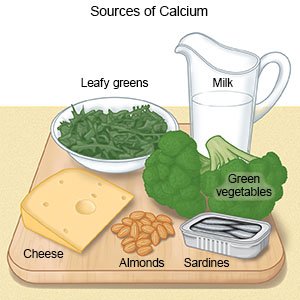
- Provide lean meats, poultry, fish, and other healthy protein foods. Other healthy protein foods include legumes (such as beans), soy foods (such as tofu), and peanut butter. Bake, broil, and grill meat instead of frying it to reduce the amount of fat.
- Use healthy fats to prepare your child's food. Unsaturated fat is a healthy fat. It is found in foods such as soybean, canola, olive, and sunflower oils. It is also found in soft tub margarine that is made with liquid vegetable oil. Limit unhealthy fats such as saturated fat, trans fat, and cholesterol. These are found in shortening, butter, margarine, and animal fat.
- Help your child limit his or her intake of fat, sugar, and caffeine. Foods high in fat and sugar include snack foods (potato chips, candy, and other sweets), juice, fruit drinks, and soda. If your child eats these foods too often, he or she may eat fewer healthy foods during mealtimes. He or she may also gain too much weight. Caffeine is found in soft drinks, energy drinks, tea, coffee, and some over-the-counter medicines. Your child should limit his or her intake of caffeine to 100 mg or less each day. Caffeine can cause your child to feel jittery, anxious, or dizzy. It can also cause headaches and trouble sleeping.
- Encourage your child to talk to you or a healthcare provider about safe weight loss, if needed. Adolescents may want to follow a fad diet they see their friends or famous people following. Fad diets usually do not have all the nutrients your child needs to grow and stay healthy. Diets may also lead to eating disorders such as anorexia and bulimia. Anorexia is refusal to eat. Bulimia is binge eating followed by vomiting, using laxative medicine, not eating at all, or heavy exercise.
How can I help my child care for his or her teeth?
- Remind your child to brush his or her teeth 2 times each day. Mouth care prevents infection, plaque, bleeding gums, mouth sores, and cavities. It also freshens breath and improves appetite.
- Take your child to the dentist at least 2 times each year. A dentist can check for problems with your child's teeth or gums, and provide treatments to protect his or her teeth.
- Encourage your child to wear a mouth guard during sports. This will protect your child's teeth from injury. Make sure the mouth guard fits correctly. Ask your child's healthcare provider for more information on mouth guards.
What can I do to keep my child safe?
- Remind your child to always wear a seatbelt. Make sure everyone in your car wears a seatbelt.
- Encourage your child to do safe and healthy activities. Encourage your child to play sports or join an after school program.
- Store and lock all weapons. Lock ammunition in a separate place. Do not show or tell your child where you keep the key. Make sure all guns are unloaded before you store them.
- Encourage your child to use safety equipment. Encourage him or her to wear helmets, protective sports gear, and life jackets.
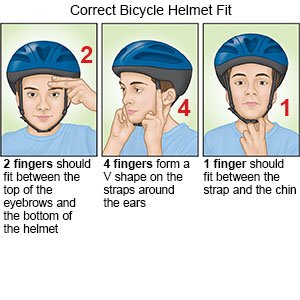
What are other ways I can care for my child?
- Talk to your child about puberty. Puberty usually starts between ages 8 to 13 in girls, but it may start earlier or later. Puberty usually ends by about age 14 in girls. Puberty usually starts between ages 10 to 14 in boys, but it may start earlier or later. Puberty usually ends by about age 15 or 16 in boys. Ask your child's healthcare provider for information about how to talk to your child about puberty, if needed.
- Encourage your child to get 1 hour of physical activity each day. Examples of physical activities include sports, running, walking, swimming, and riding bikes. The hour of physical activity does not need to be done all at once. It can be done in shorter blocks of time. Your child can fit in more physical activity by limiting screen time.
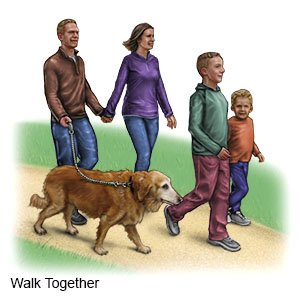
- Limit your child's screen time. Screen time is the amount of television, computer, smart phone, and video game time your child has each day. It is important to limit screen time. This helps your child get enough sleep, physical activity, and social interaction each day. Your child's pediatrician can help you create a screen time plan. The daily limit is usually 1 hour for children 2 to 5 years. The daily limit is usually 2 hours for children 6 years or older. You can also set limits on the kinds of devices your child can use, and where he or she can use them. Keep the plan where your child and anyone who takes care of him or her can see it. Create a plan for each child in your family. You can also go to https://www.healthychildren.org/English/media/Pages/default.aspx#planview for more help creating a plan.
- Praise your child for good behavior. Do this any time he or she does well in school or makes safe and healthy choices.
- Monitor your child's progress at school. Go to parent-teacher conferences. Ask your child to let you see your child's report card.
- Help your child solve problems and make decisions. Ask your child about any problems or concerns he or she has. Make time to listen to your child's hopes and concerns. Find ways to help your child work through problems and make healthy decisions.
- Help your child find healthy ways to deal with stress. Be a good example of how to handle stress. Help your child find activities that help him or her manage stress. Examples include exercising, reading, or listening to music. Encourage your child to talk to you when he or she is feeling stressed, sad, angry, hopeless, or depressed.
- Encourage your child to create healthy relationships. Know your child's friends and their parents. Know where your child is and what he or she is doing at all times. Encourage your child to tell you if he or she thinks he or she is being bullied. Talk with your child about healthy dating relationships. Tell your child it is okay to say "no" and to respect when someone else says "no."
- Encourage your child not to use drugs, tobacco, nicotine, or alcohol. By talking with your child at this age, you can help prepare him or her to make healthy choices as a teenager. Explain that these substances are dangerous and that you care about your child's health. Nicotine and other chemicals in cigarettes, cigars, and e-cigarettes can cause lung damage. Nicotine and alcohol can also affect brain development. This can lead to trouble thinking, learning, or paying attention. Help your teen understand that vaping is not safer than smoking regular cigarettes or cigars. Talk to him or her about the importance of healthy brain and body development during the teen years. Choices during these years can help him or her become a healthy adult.
- Be prepared to talk your child about sex. Answer your child's questions directly. Ask your child's healthcare provider where you can get more information on how to talk to your child about sex.
Which vaccines and screenings may my child get during this well child visit?
- Vaccines include influenza (flu) every year. Tdap (tetanus, diphtheria, and pertussis), MMR (measles, mumps, and rubella), varicella (chickenpox), meningococcal, and HPV (human papillomavirus) vaccines are also usually given.

- Screening may be needed to check for sexually transmitted infections (STIs). Screening may also be used to check your child's lipid (cholesterol and fatty acids) level. Anxiety or depression screening may also be recommended. Your child's healthcare provider will tell you more about any screenings, follow-up tests, and treatments for your child, if needed.
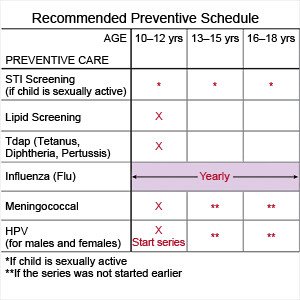
What do I need to know about my child's next well child visit?
Your child's healthcare provider will tell you when to bring your child in again. The next well child visit is usually at 15 to 18 years. Your child may be given meningococcal, HPV, MMR, or varicella vaccines. This depends on the vaccines your child was given during this well child visit. He or she may also need lipid or STI screenings if any was not done during this visit. Information about safe sex practices may be given. These practices help prevent pregnancy and STIs. Contact your child's healthcare provider if you have questions or concerns about your child's health or care before the next visit.
Care Agreement
You have the right to help plan your child's care. Learn about your child's health condition and how it may be treated. Discuss treatment options with your child's healthcare providers to decide what care you want for your child. The above information is an educational aid only. It is not intended as medical advice for individual conditions or treatments. Talk to your doctor, nurse or pharmacist before following any medical regimen to see if it is safe and effective for you.© Copyright Merative 2025 Information is for End User's use only and may not be sold, redistributed or otherwise used for commercial purposes.
Learn more about Well Child Visit at 11 to 14 Years
Care guides
Further information
Always consult your healthcare provider to ensure the information displayed on this page applies to your personal circumstances.
